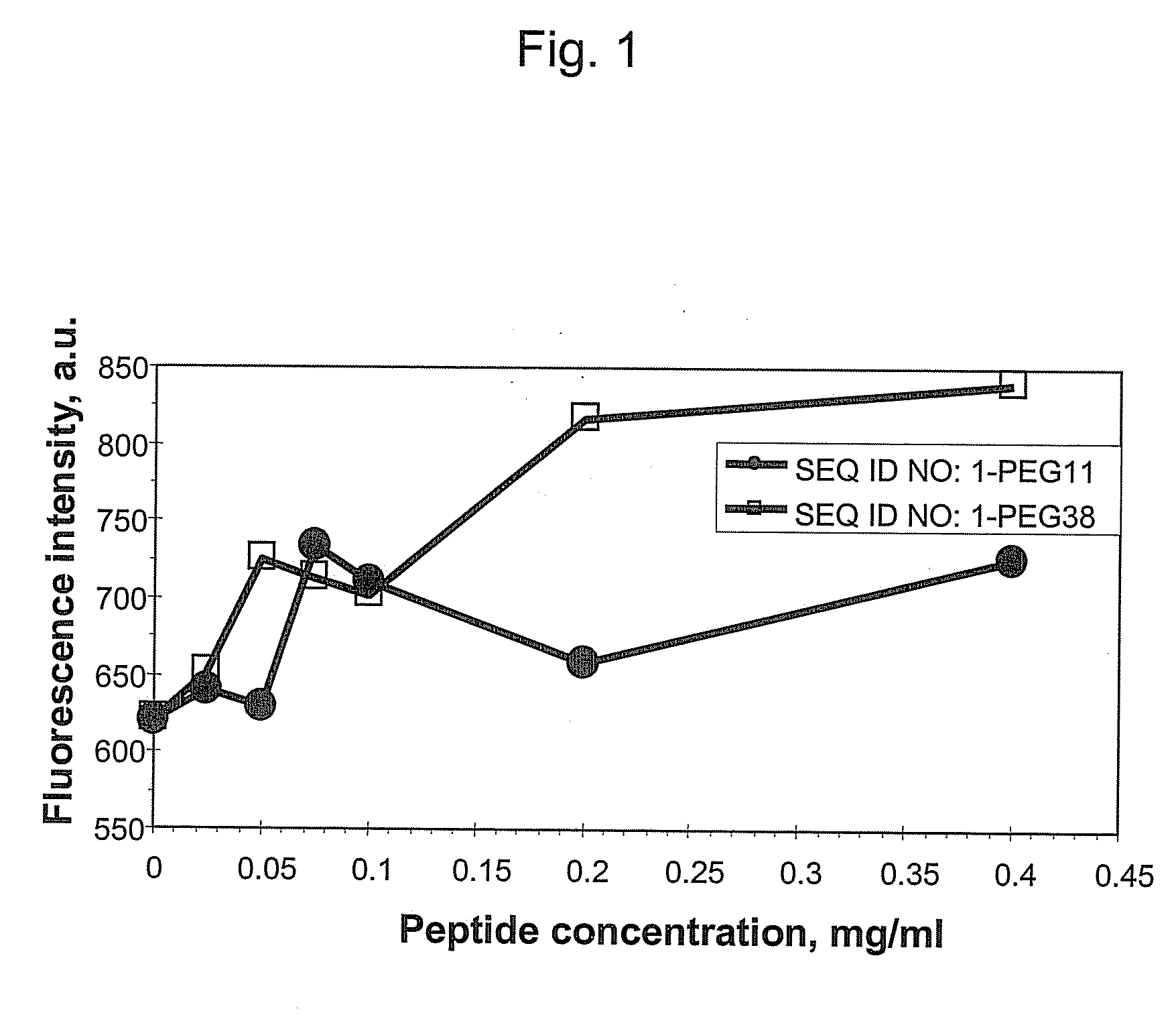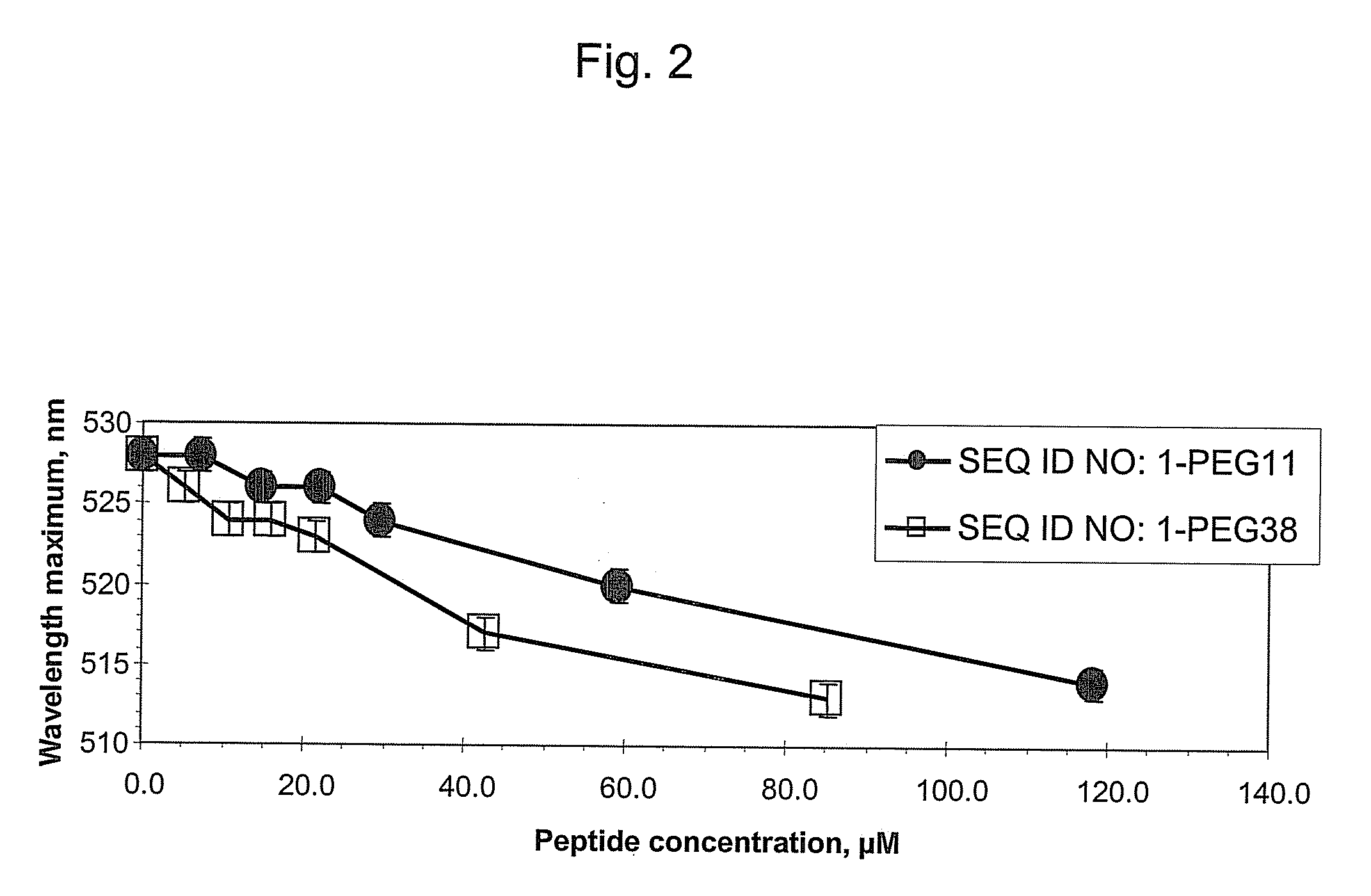Self-assembling nanoparticles composed of transmembrane peptides and their application for specific intra-tumor delivery of Anti-cancer drugs
a transmembrane peptide, self-assembling technology, applied in the direction of drug composition, peptide/protein ingredients, cardiovascular disorders, etc., can solve the problems of lack of stability and reproducibility of liposomes, hampered wide-scale liposome use,
- Summary
- Abstract
- Description
- Claims
- Application Information
AI Technical Summary
Benefits of technology
Problems solved by technology
Method used
Image
Examples
example 1
[0031]This example demonstrates that the nanoparticles of the invention have uniform shape and diameter.
[0032]Peptides comprising the amino acid sequences of SEQ ID NO: 1, SEQ ID NO: 2, SEQ ID NO: 3, SEQ ID NO: 4, and SEQ ID NO: 5 were synthesized. Additionally, a peptide comprising the amino acid sequence of Leu-Leu-Phe-Val-Ile-Thr-Leu-Pro-Phe-Trp-Ala-Val-Asp-Ala-Val-Ala-Asn-Trp-Tyr-Phe-Gly-Asn-Lys-Lys (SEQ ID NO: 6), which replaces the two negatively charged aspartate residues at the end of SEQ ID NO: 1 with two positively charged lysine residues, was synthesized.
[0033]Peptides were solubilized in DMSO to yield 32 mg / ml solution. DMSO stocks were diluted with phosphate buffered saline (PBS) to produce 0.05-0.5 mg / ml solutions. Two μl of a sample were applied directly on microscopy grids, air-dried, stained with 0.5% (w / v) osmium tetroxide (OsO4), and visualized with a Hitachi H-7000 electron microscope.
[0034]All peptides with a negatively charged end produced small nanoparticles (...
example 2
[0036]This example demonstrates that addition of hydrophilic oligomers affects nanoparticle aggregation.
[0037]Hydrophilic oligomers were added to a TM peptide with the amino acid sequence of SEQ ID NO: 1 to form the following: SEQ ID NO: 1-PEG11; SEQ ID NO: 1-PEG27; SEQ ID NO: 1-PEG38; and SEQ ID NO: 1-GGGGG.
[0038]To form peptides with hydrophilic oligomers (e.g., PEG), Fmoc amide resin (Applied Biosystem) was deprotected on an ABI433 peptide synthesizer. One gram of Fmoc-NH-(PEG)11-COOH (NovaBiochem) or Fmoc-NH-(PEG)27-COOH (NovaBiochem) were dissolved in 10 ml N-methyl-2-pyrrolidone (NMP) and activated by the addition of equimolar amounts of a 0.5 M solution of HBTU / HOBt (O-benzotriazole-N,N,N′,N′-tetramethyl-uronium-hexafluoro-phosphate / 1-hydroxy-benzotriazole) in dimethylformamide (DMF). Deprotected resin (80% moles in relationship to PEG) were added to the activated PEG and left on a shaker for 18 hours. For longer PEG molecules, like Fmoc-NH-(PEG)38-COOH, the procedure was rep...
example 3
[0048]This example demonstrates that the length of the TM peptides affects nanoparticle aggregation.
[0049]To determine the influence of TM peptide length on nanoparticle aggregation, the degree of aggregation was determined by multi-angle light scattering for TM peptides of SEQ ID NO: 1-PEG27; SEQ ID NO: 7-PEG27; SEQ ID NO: 8-PEG27; and SEQ ID NO: 9-PEG27. SEQ ID NOs: 7, 8, and 9 are related to SEQ ID NO: 1 as deletion mutants, wherein SEQ ID NO: 7 lacks the two N-terminal amino acid residues of SEQ ID NO: 1, SEQ ID NO: 8 lacks the five N-terminal amino acid residues of SEQ ID NO: 1, and SEQ ID NO: 9 lacks the twelve N-terminal amino acid residues of SEQ ID NO: 1. The peptides were formed as described in Example 2.
[0050]The results are set forth in Table 2.
TABLE 2Influence of the transmembrane part length on nanoparticle aggregation.0.05 mg / ml0.1 mg / ml0.2 mg / ml0.4 mg / mlMWMWMWMWPeptide(g / mol)N(g / mol)N(g / mol)N(g / mol)NSEQ ID NO: 1-PEG271,171,000 ± 190,000286719,400 ± 100,700176682,000 ...
PUM
| Property | Measurement | Unit |
|---|---|---|
| diameter | aaaaa | aaaaa |
| diameter | aaaaa | aaaaa |
| diameter | aaaaa | aaaaa |
Abstract
Description
Claims
Application Information
 Login to View More
Login to View More - R&D
- Intellectual Property
- Life Sciences
- Materials
- Tech Scout
- Unparalleled Data Quality
- Higher Quality Content
- 60% Fewer Hallucinations
Browse by: Latest US Patents, China's latest patents, Technical Efficacy Thesaurus, Application Domain, Technology Topic, Popular Technical Reports.
© 2025 PatSnap. All rights reserved.Legal|Privacy policy|Modern Slavery Act Transparency Statement|Sitemap|About US| Contact US: help@patsnap.com



